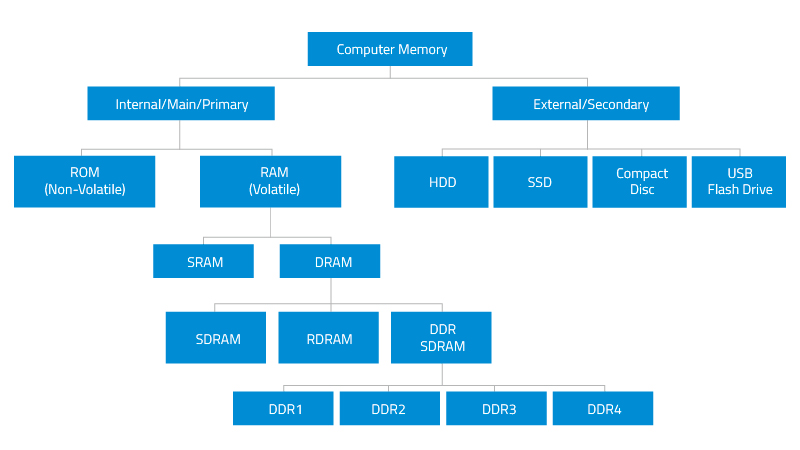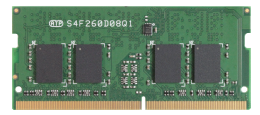What Size Dimm Is Used By Laptop Ddr4 Sdrams?
Understanding RAM and DRAM Calculator Memory Types
DRAM Modules 2018-10-25
What is internal memory and how is it different from external memory?
Computer retention is mostly classified as either internal or external memory.
Internal retentivity, also called "principal or primary retention" refers to memory that stores small amounts of data that tin can be accessed quickly while the calculator is running.
External memory, also called "secondary memory" refers to a storage device that tin can retain or store data persistently. They could be embedded or removable storage devices. Examples include hard disk drive or solid land drives, USB flash drives, and compact discs.
What are the types of internal memory?
There are basically two kinds of internal retentivity: ROM and RAM.
ROM stands for read-only memory. It is non-volatile, which means it can retain data even without power. It is used mainly to start or kick upward a computer.
In one case the operating system is loaded, the computer uses RAM , which stands for random-access retention, which temporarily stores data while the central processing unit (CPU) is executing other tasks. With more RAM on the estimator, the less the CPU has to read data from the external or secondary memory (storage device), allowing the reckoner to run faster. RAM is fast but it is volatile, which ways information technology volition not retain data if there is no ability. Information technology is therefore important to salvage data to the storage device before the system is turned off.
What are the types of RAM?
There are two main types of RAM: Dynamic RAM (DRAM) and Static RAM (SRAM).
- DRAM (pronounced DEE-RAM), is widely used as a estimator'south main retention. Each DRAM memory cell is made upwardly of a transistor and a capacitor within an integrated excursion, and a information scrap is stored in the capacitor. Since transistors always leak a modest amount, the capacitors will slowly belch, causing information stored in it to drain; hence, DRAM has to be refreshed (given a new electronic accuse) every few milliseconds to retain information.
- SRAM (pronounced ES-RAM) is fabricated upwards of 4 to six transistors. It keeps data in the memory every bit long every bit ability is supplied to the system unlike DRAM, which has to be refreshed periodically. Equally such, SRAM is faster but too more expensive, making DRAM the more than prevalent memory in reckoner systems.
What are the common types of DRAM?
-
Synchronous DRAM (SDRAM) "synchronizes" the memory speed with CPU clock speed so that the memory controller knows the verbal clock cycle when the requested data will be set. This allows the CPU to perform more than instructions at a given time. Typical SDRAM transfers data at speeds up to 133 MHz.
-
Rambus DRAM (RDRAM) takes its proper noun after the company that made it, Rambus. It was pop in the early 2000s and was mainly used for video game devices and graphics cards, with transfer speeds upward to 1 GHz.
-
Double Data Charge per unit SDRAM (DDR SDRAM) is a type of synchronous memory that nearly doubles the bandwidth of a single data rate (SDR) SDRAM running at the same clock frequency by employing a method called "double pumping," which allows transfer of information on both the rise and falling edges of the clock indicate without any increase in clock frequency.
-
DDR1 SDRAM has been succeeded past DDR2,DDR3 , and nigh recently, DDR4 SDRAM. Although operating on the aforementioned principles, the modules are not backward-compatible. Each generation delivers college transfer rates and faster operation. The latest DDR4 modules, for example, feature fast transfer rates at 2133/2400/2666and even 3200 MT/s.

Figure 1. Types of computer retentivity.
What are the types of DRAM packages?
-
Unmarried In-Line Memory Module (SIMM)
SIMM modules were widely used from the late 1980s to 1990s, and are now obsolete. They typically had 32-bit information bus and were available in two physical types—30- and 72-pivot. -
Dual In-Line Retentiveness Module (DIMM)
Current memory modules come up in DIMMs. "Dual in-line" refers to pins on both sides of the modules. A DIMM originally had a 168-pin connector supporting 64-chip information double-decker, which is twice the information width of SIMMs. The wider motorbus means that more data tin can pass through a DIMM, translating to faster overall operation. Latest DIMMs based on quaternary-generation double data rate (DDR4) SDRAM have 288-pin connectors for increased information throughput.
What are the common types of DIMM?
In that location are several DIMM architectures. Different platforms tin accommodate dissimilar retention types so information technology is best to check which modules are supported on the motherboard. Here are the about common standard DIMMs, with a typical length of 133.35 mm and elevation of 30 mm.
| DIMM Type | Description |
| Unbuffered DIMMs | Used mainly on desktop and laptop computers. They run faster and cost less, only are non as stable every bit registered memory. Commands go direct from the memory controller residing in the CPU to the memory module. |
| Fully buffered DIMMs | Typically used as master retention in systems requiring large capacities such as servers and workstations, FB-DIMMs use advanced retentivity buffer (AMB) fries to increment reliability, maintain signal integrity and better mistake detection methods to reduce soft errors. The AMB autobus is carve up into a 14-bit read omnibus and a ten-bit write motorbus. By having a dedicated read/write omnibus, reads and writes can happen simultaneously, resulting in increased performance. Lesser pin counts (69 pins per serial aqueduct compared with 240 pins on parallel channels), issue in bottom routing complication and allowing smaller board designs for meaty, small grade factor systems. |
| Registered DIMMs | As well known as "buffered" memory, are often used in servers and other applications requiring stability and robustness. RDIMMs feature onboard memory registers (hence the name "registered") placed betwixt the memory and retentivity controller. The memory controller buffers Command, Addressing and Clock Cycling, directing instructions to the dedicated memory registers instead of accessing the DRAM direct. Every bit a effect, the instructions could take approximately one CPU bike longer, simply the buffering reduces the strain on the CPU's retentivity controller. |
| Load Reduced DIMMs | Utilise Isolation Memory Buffer (iMB) technology, which reduces the load on the memory controller by buffering both data and address lanes. Dissimilar the register on RDIMMs which buffer only Command, Addressing and Clock Cycling, the iMB flake also buffers data signals. The iMB chip isolates all electric loading including data signals of the DRAM chips on the DIMM from the retentiveness controller, so the memory controller just sees the iMB and not the DRAM chips. The memory buffer then handles all reads and writes to the DRAM fries, boosting both capacity and speed. (Source: Isolation Retentiveness Buffer) |
Table 1. Common types of DIMMs.
Aside from standard-size DIMMs, are there modest form cistron DIMMs for infinite-constrained systems?
Pocket-size outline DIMMs (SO-DIMMs) are the smaller alternatives to DIMMs. While the standard DDR4 DIMM is about 133.35 mm in length, So-DIMMs are just about half the size of regular DIMMs at 69.6 mm long, making them ideal for ultra-portable devices. Both usually have a height of 30 mm merely may exist available in very low profile (VLP) format at 20.3 mm tall or ultra-low contour (ULP) at 17.eight to eighteen.2 mm. Some other type of pocket-size form factor DIMM is the Mini-RDIMM, which has a length of simply 82 mm compared with 133 mm of regular RDIMMs.
ATP DRAM Products
ATP offers industrial memory modules in different architectures, capacities and course factors. ATP DRAM modules are normally used in industrial PCs and embedded systems. Resistant confronting vibration, shock, dust and other challenging conditions, ATP DRAM modules perform well even under the well-nigh enervating workloads and applications, equally well as in different operating environments.
Committed to product longevity, ATP also continues to offering legacy DRAM modules in select grade factors under its license understanding with Micron Technology, Inc. For information on ATP'south legacy SDRAM products, visitLegacy SDRAM.
To ensure high reliability, ATP conducts thorough testing and validation from IC level upwards to module and product levels usingAutomatic Testing Equipment (ATE) for various electrical parameters such as marginal voltage, point frequency, clock, control timing and data timing under continuous thermal cycles.Test During Burn-In (TDBI) employs a special mini thermal chamber where modules are subjected to low and elevated thermal tests to screen out defective components and minimize IC baby mortality, thus ensuring higher production quality and reducing actual field failures.
The tabular array below shows ATP's DDR4 DRAM products.
| DIMM Type | Size (50 x H mm) / Image |
| DDR4 | Standard: 133.35 x 31.25 Very Low Profile (VLP): 133.35 x 18.75 |
| DDR4 | 133.35 x 31.25 |
| DDR4 | 69.six x 30 |
| DDR4 | Very Low Profile (VLP): 80 x 18.75 |
Tabular array two. ATP DDR4 DRAM products. (Non-ECC versions are also available.)
The table below shows a size comparison among different types of DRAM modules.
| DIMM Type | Size (L x H mm) | |
| DDR4 | Standard | 133.35 x 31.25 |
| VLP (Very Low Contour) | 133.35 10 18.75 | |
| DDR3 | Standard | 133.35 x thirty |
| VLP | 133.35 x xviii.28 to 18.79 | |
| ULP (Ultra-Low Contour) | 133.35 x 17.78 to xviii.28 | |
| DDR2 | Standard | 133.35 x 30 |
| VLP | 133.35 ten 18.28 to 18.79 | |
| DDR | Standard | 133.35 x xxx |
| VLP | 133.35 x 18.28 to xviii.79 | |
| SDRAM | Standard | 133.35 x 25.4 to 43.18 |
Table 3. Comparison of DDR4/DDR3/DDR2/DDR dimensions.
Dorsum to Blog
What Size Dimm Is Used By Laptop Ddr4 Sdrams?,
Source: https://www.atpinc.com/blog/computer-memory-types-dram-ram-module
Posted by: foltzabsetiley.blogspot.com







0 Response to "What Size Dimm Is Used By Laptop Ddr4 Sdrams?"
Post a Comment